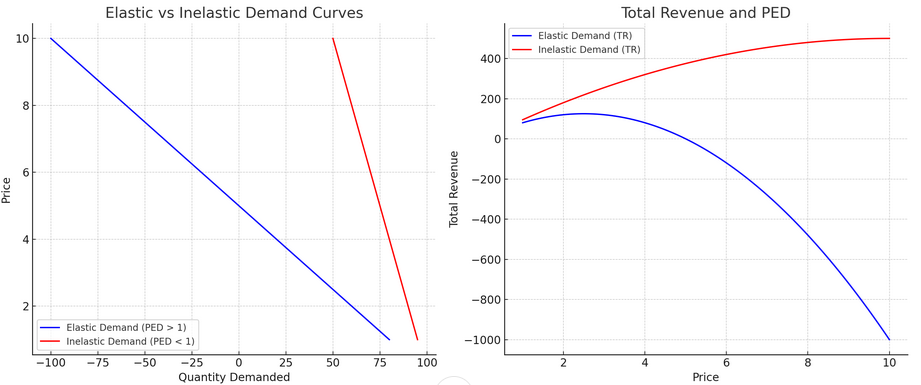Price Elasticity of Demand (PED)
This section explains price elasticity of demand covering, the calculation of price elasticity of demand, the interpretation of numerical values of PED, the factors influencing price elasticity of demand, the significance of PED to businesses and PED and total revenue: calculation and interpretation.
Calculation of Price Elasticity of Demand
Price elasticity of demand (PED) measures the responsiveness of quantity demanded to a change in price.
Formula:
$$\text{PED} = \frac{\% \text{ change in quantity demanded}}{\% \text{ change in price}}$$
- A negative value is usually obtained (due to the inverse relationship between price and demand), but it is often interpreted in absolute terms.
Interpretation of Numerical Values of PED
| PED Value | Interpretation |
|---|---|
| PED > 1 | Price elastic – demand is sensitive to price changes |
| PED < 1 | Price inelastic – demand is relatively unresponsive |
| PED = 1 | Unitary elasticity – proportional response |
| PED = 0 | Perfectly inelastic – no change in demand |
| PED = ∞ | Perfectly elastic – demand drops to zero if price rises |
- Elastic demand: A small change in price causes a larger change in quantity demanded.
- Inelastic demand: A change in price causes a smaller change in quantity demanded.

Left chart: Elastic vs Inelastic Demand Curves
- The blue curve shows elastic demand (flatter curve – large change in quantity with small price change).
- The red curve shows inelastic demand (steeper curve – quantity changes little with price change).
Right chart: Relationship between Price and Total Revenue (TR)
- With elastic demand, lowering price increases TR.
- With inelastic demand, raising price increases TR.
Factors Influencing Price Elasticity of Demand
- Availability of substitutes – More substitutes = more elastic.
- Necessity vs luxury – Necessities tend to be inelastic; luxuries are more elastic.
- Proportion of income – Expensive items (as a % of income) tend to be more elastic.
- Time period – Demand is usually more elastic in the long run than the short run.
- Brand loyalty – Strong brand loyalty reduces elasticity.
- Definition of the market – A broader market (e.g., food) tends to be inelastic; a narrower market (e.g., strawberries) is more elastic.
Significance of PED to Businesses (Implications for Pricing)
- Pricing decisions:
Businesses must consider PED when setting or changing prices.- If demand is elastic, a price decrease could increase total revenue.
- If demand is inelastic, a price increase could increase total revenue.
- Revenue forecasting:
Understanding PED helps forecast how changes in price may affect sales and revenue. - Strategic planning:
PED influences product development, marketing strategies, and entry into new markets. - Competitive response:
Firms with elastic products must be cautious in raising prices due to the risk of losing customers to rivals.
PED and Total Revenue: Calculation and Interpretation
Total Revenue (TR):
$$\text{TR} = \text{Price} \times \text{Quantity sold}$$
Relationship with PED:
| Elasticity | Price ↑ | Price ↓ |
|---|---|---|
| Elastic (PED > 1) | TR decreases | TR increases |
| Inelastic (PED < 1) | TR increases | TR decreases |
| Unitary (PED = 1) | TR remains unchanged | TR remains unchanged |
- When PED is known, businesses can predict how changes in pricing will influence revenue.
- In elastic markets, discount strategies can increase total revenue.
- In inelastic markets, price hikes can be profitable without significantly reducing sales volume.
